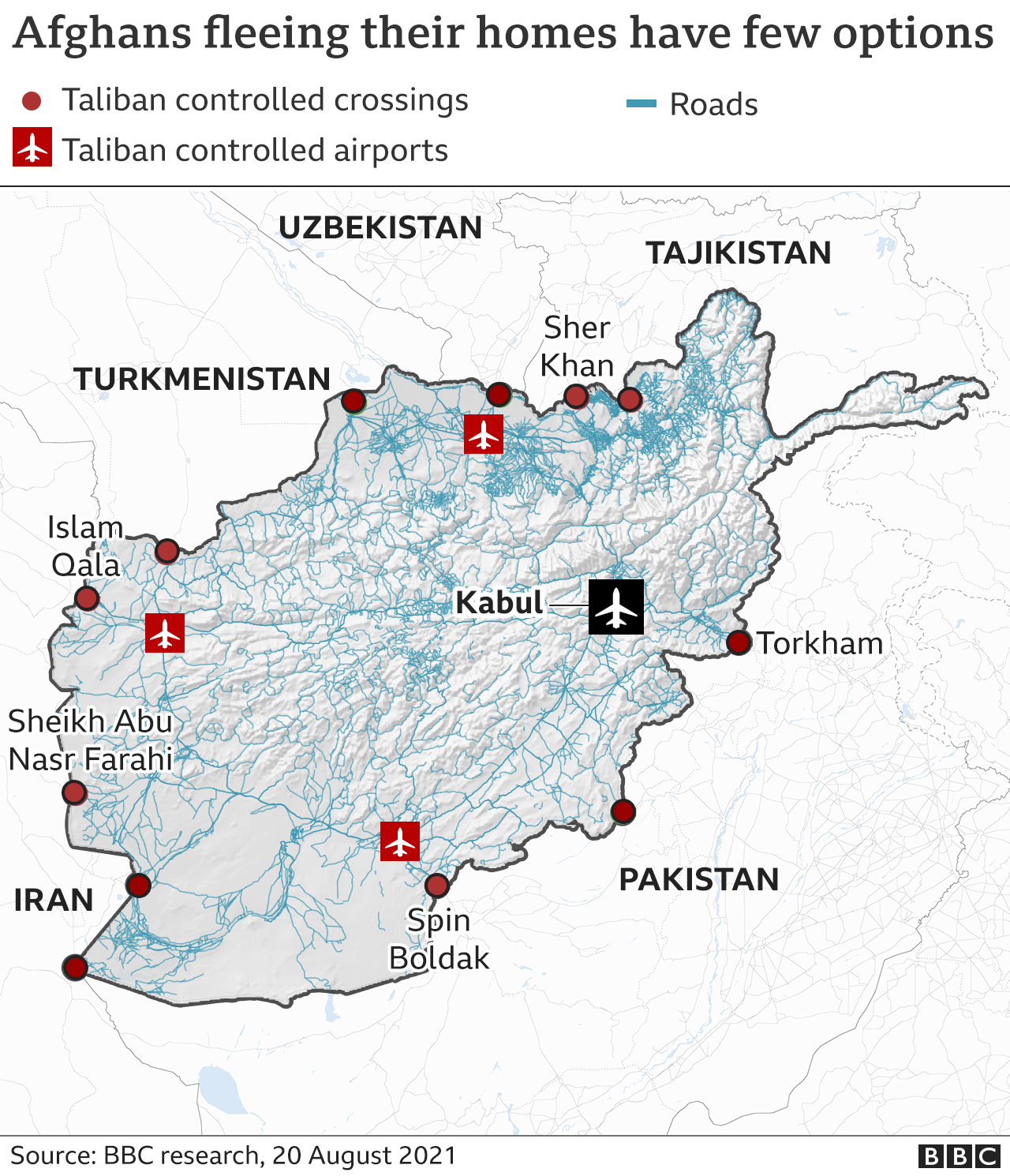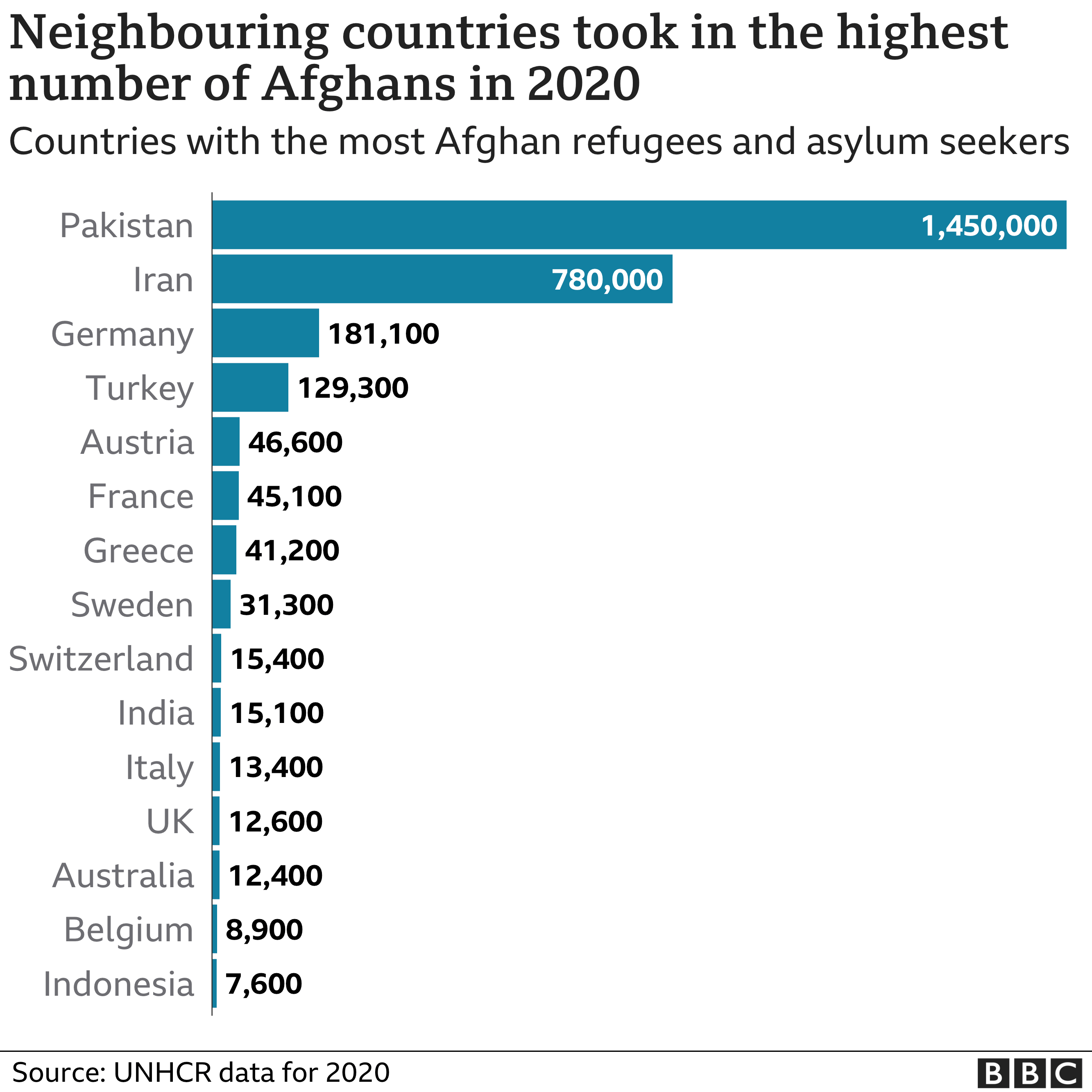Afghanistan Refuges Camps: The surge in numbers trying to leave comes on top of the 2.2 million refugees already in neighboring countries and 3.5 million people left homeless within Afghanistan’s borders as a result of ongoing conflict and political instability.
How many Afghans are leaving?
At the moment, it is not clear.
The Taliban controls all major land crossings with Afghanistan’s neighbors (shown on the map below) and militants have said they don’t want the Afghans to leave the country. Reports suggest that only traders or those with valid travel documents are allowed to cross.
“The vast majority of Afghans are unable to leave the country through regular channels,” a spokesperson for the United Nations High Commissioner for Refugees (UNHCR) said on Friday. “To this day, those who might be in danger have no clear way out.”


However, some refugees have managed to find a way out of the country.
Several thousand Afghans are said to have entered Pakistan shortly after the Taliban took control of Kabul, while some 1,500 Afghans are said to have entered Uzbekistan and are living in tents near the border.
In Kabul, thousands of people made their way to the international airport, currently the only operational in the country, in a desperate attempt to flee.
On Friday, a NATO official said more than 18,000 people had been evacuated from the airport since the Taliban took power, but it is not known how many of them were Afghan nationals.
How many have fled their homes?
The latest movement of Afghans is part of a historic exodus from a country plagued by instability and conflict for many years.
Even before the Taliban regained control, more than 550,000 people had been forced to flee their homes this year because of the fighting, according to UNHCR.
This means that around 3.5 million Afghans are currently internally displaced.
In addition to those within Afghanistan’s borders, an estimated 2.2 million refugees and asylum seekers were also seeking refuge in neighboring countries at the end of last year.
This year, Afghans have also faced severe drought and food shortages across much of the country. A report from the United Nations World Food Program released in June indicated that 14 million people – more than a third of the population – were hungry.
Where are the Afghan refugees going?
Neighboring countries Pakistan and Iran recorded the highest number of Afghan refugees and asylum seekers last year.
Nearly 1.5 million people fled to Pakistan in 2020, while Iran took in 780,000, according to UNHCR figures.


Germany was third, with over 180,000, while Turkey took almost 130,000.
If we consider only the number of asylum seekers – those who have requested refuge in another country but whose applications have not yet been accepted – Turkey, Germany and Greece top the list, with approximately 125,000, 33,000, and 20,000 respectively.
Although there are no Afghan asylum seekers in Iran, those with a refugee card – an official document recognizing their status – can access the country’s health and education systems.
What are countries doing to help?
While some countries have offered refuge to Afghans, others have indicated that they will not offer refuge to those who flee.
Iran
Iran has set up emergency tents for refugees in three of its provinces bordering Afghanistan. But senior Iranian interior ministry officials said any Afghan who crossed into Iran would be “once conditions improve, would be repatriated.” Iran already hosts nearly 3.5 million Afghans, according to the UN.
Pakistan
In June, Prime Minister Imran Khan said that his country would seal its border with Afghanistan if the Taliban took control. However, reports indicate that several thousand Afghans have entered Pakistan and that at least one border post is open. The Taliban would restrict access to traders and holders of valid travel documents.
Tajikistan
The exact figures are not clear, but reports suggest that at least several hundred Afghans, including Afghan National Army soldiers, have entered Tajikistan in recent days. In July, Tajikistan said it was preparing to welcome up to 100,000 Afghan refugees.
Uzbekistan
About 1,500 Afghans are said to have crossed the border between Afghanistan and Uzbekistan and set up camp. Reports suggest that the Taliban only allow people with valid visas to use official border crossings.
UK
The UK has announced its intention to accept 20,000 long-term Afghan refugees. The UK Government’s Afghan Citizens Resettlement Program will aim to move 5,000 Afghans to the UK in the first year and will focus on women and children as well as religious and other minorities most at risk from the Taliban.
US
President Joe Biden has authorized $ 500 million (£ 367 million) for “the urgent and unexpected refugee and migration needs of refugees, victims of conflict and others at risk due to the situation in Afghanistan, including applicants for special immigrant visas ”. The United States has not announced the exact number of refugees it will allow.
Canada
Canada has said it will resettle 20,000 Afghans, focusing on those threatened by the Taliban, including government officials and women leaders.
Australia
Australia has announced that it will offer 3,000 places to Afghans fleeing their country in its humanitarian visa program. But places will come from the existing humanitarian visa program available, and there will be no increase in the overall number.
European Union
Officials from several European Union countries have said they want to avoid a repeat of the migrant crisis of 2015 when there was a populist backlash against large numbers of refugees allowed to enter the territory. ‘EU.
Germany
Germany has indicated that it will accept some Afghans but did not specify their number. Chancellor Angela Merkel, who came under heavy criticism for her open-door policy towards migrants in 2015, said her government was working to ensure refugees “have a safe stay in countries neighboring Afghanistan “.
France
President Emmanuel Macron said Europe must “protect itself from the large waves of illegal migrants” from Afghanistan. He said France would “protect those who are most at risk”, but added: “Europe cannot shoulder the consequences of the current situation on its own”.
Austria
Austria has ruled out welcoming Afghan refugees. The country’s interior minister pleaded for the continued deportation of failed Afghan asylum seekers and lobbied for the establishment of “deportation centers” in countries neighboring Afghanistan, where direct deportation to Afghanistan is not possible.
Switzerland
Switzerland has said it will not accept large groups of refugees arriving directly from Afghanistan.
Turkey
President Recep Tayyip Erdogan said his government would work with Pakistan to help stabilize Afghanistan and prevent a new wave of refugees from heading to Turkey. The government has also stepped up the construction of a border wall with Iran to prevent migrants from entering.
North Macedonia, Albania, and Kosovo
North Macedonia and Albania have said they will temporarily host 450 and 300 refugees respectively at the request of the United States. Refugees are expected to stay until documentation for U.S. immigration visas can be arranged. Kosovo also plans to provide temporary shelter for refugees heading to the United States but did not specify the number.
Uganda
Uganda has agreed to host 2,000 Afghan refugees. The East African nation has the highest number of refugees of any African country – and the third-largest in the world.
ALSO READ: PM Boris Johnson statement about working with Taliban

